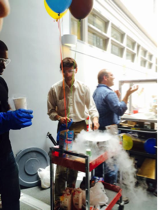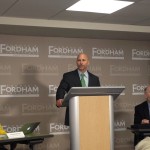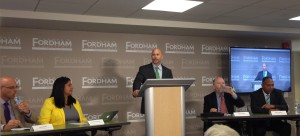Last week, I listened to American Institutes for Research’s webinar “Socioeconomically Disadvantaged Students Who Are Academically Successful: Examining Academic Resilience Cross-Nationally”.
Maria Stephens and Ebru Erberber, Senior Researchers at American Institutes for Research, observed the discrepancies between marginalized students and their ability to thrive academically. They investigated the prevalence of “academic resilience” internationally as well as the factors influencing this success. Sean McComb, 2014 National Teacher of the Year, discussed the implications of their analysis and results. He suggested ways to increase academic achievement among those who are underprivileged.
Erberber claimed that it is the school’s initial responsibility to expose students to higher educational options and various fields of study. Academic success thereby stems from student aspiration and teacher encouragement.
McComb then stressed the importance of personalized learning and professional development.
Stephens, Erberber, and McComb offered valuable insight about inequities within and across education systems. They briefly discussed policy implementation, but did not fully engage in a conversation about potential practices that could reshape the education landscape, which disappointed me.
Socioeconomic status should not be a determinant of a child’s academic success, but all too often, it is. I believe it would have been beneficial to talk about educational policy in relation to their findings and analysis. We need more policies to make schools responsible for student outcomes and not just enrollment. This strategy would incentivize administrators and teachers to provide students with all of the information they need to reach their goals, whether it be to graduate high school, go immediately to the workforce, or attend a two or four-year college.
Being fully aware of these options has unfortunately become a privilege, but every student is entitled to understand their choices. We cannot bridge the achievement gap between socioeconomic classes without increased accountability and greater transparency between students, teachers, and administrators.
Hayley Nicholas, CER Intern



















Expanding Options and Changing Stigmas
Over the past few decades, primary and secondary education have been rethought, reshaped, and rebranded. Amidst the changes in the K-12 world, there have been stigmas attached to different styles of education just as there are in the post-secondary world. Although the options in post-secondary education outnumber those in primary and secondary education, stigmas persist about what choices are better than others. A four-year university option is perceived as more prestigious than a community college option due to nomenclature. Expanding the options and reducing the stigma of alternative styles of higher education would not only ensure success in higher education for all students, but also equip more individuals with the tools for success. Just as school choice is important for K-12 education, changing the stigma of choices in post-secondary education needs to be on the top of our list.
Post-secondary education has shown the education world how important it is to give students options. Expanding options equips more individuals with the tools for success. The Brookings Institution hosted several panels on the importance of choice in post-secondary education and the need to enhance the experience for students. The panelists’ ideas, although specific to post-secondary education, parallel the need for choice in primary and secondary education. Providing more education options can only improve both sectors of education. Just as some post-secondary students excel in a traditional, four-year college experience and others excel in a certification program at a community college, some K-12 students can excel in a traditional public school and others excel in an alternative charter school setting. The acceptance of alternative modes of K-12 education should ideally be transferred to the post-secondary realm, while the abundance of options in the post-secondary realm should be paralleled in the K-12 sector.
As DeRionne Pollard, the president of Montgomery College noted, “you don’t have to go to college, you just have to get an education”. Whether you are in the K-12 sector or the post-secondary world, education is the number one objective.
Emily Kelleher, Elizabeth Kennard, and Madeline Ryan, CER Interns